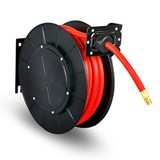1. Pick the two known values.
2. Lay a straightedge to intersect the two values.
3. Intersection on the third vertical line gives the value of that factor.
Example:
To find the bore size for a pressure line consistent with a Flow Rate of 100 litres per minute (26 US or 22 Imperial gallons per minute), and a Flow Velocity of 4,5 metres per second (14.8 feet per second), connect Flow Rate to Flow Velocity and read Hose Bore on centre scale.
Answer:
The line crosses Hose Bore between -12 and -16 on "All Other Dash Sizes" side of Hose Bore axis, so a -16 hose is required. If RQP5 or T5 Hose is to be used, for this example -16 would also be required.
Notes:
- The velocity of the fluid should not exceed the range shown in the right hand column.
- When oil velocities are higher than recommended in the chart, turbulent flow occurs, resulting in loss of pressure and excessive heating.
- For long hoses and/or high viscosity oil, or if the flow of hydraulic fluid is continuous, it is recommended to use figures at the lower end of the Maximum Recommended Velocity range.
- For short hoses and/or low viscosity oil, or if the flow of hydraulic fluid is intermittent or for only short periods of time, figures at the higher end of the Maximum Recommended Velocity range can be used.
Should you have any questions about a particular requirement feel free to call or email us.


























